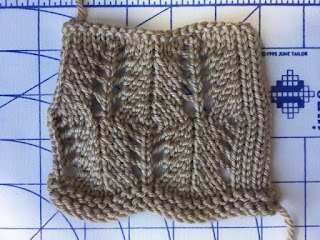I have run into a very unexpected challenge in converting the Kohi Shawl's lace pattern from hand knit to machine knit, one that perhaps a more experienced machine knitter might have anticipated and have an immediate solution for, or perhaps not. I can tell you, though, it nearly broke my brain. So let me lay out for you this curious problem.
First, have a good look at the picture of the shawl (link above). It is a very nice and basic eyelet lace with a vertical wave, and the lace pattern is actually called "waves of wheat" (or "wheat waves", or "waves of grain", depending on your source). The chart for it is as so (highlight added by me to show the repeat):
Not bad, right? The three-pronged transfer tool should do the trick for the hand manipulation, with a single prong on the opposite end to deal with whether or not the decreases should be 2-step or 1-step (more on that later).
To test the lace pattern I used some scrap yarn and just made a small swatch like so:
 Look at it carefully. There's maybe a tiny bit of "wave" but nothing like in the picture that accompanies the Kohi pattern. I wondered if perhaps my swatch was too small to show the effect, or maybe I wasn't translating the decreases properly? So I made a second swatch on the machine, and did 2-step decreases to see if that would make any difference. A 2-step decrease is where you move the fourth stitch over to the third stitch of the set of three you are moving and then move the set of three to the right or left to fill that empty needle left by the fourth stitch (depending on which direction you are going with the decrease). The tan swatch below is the second of my machine knit swatches.
Look at it carefully. There's maybe a tiny bit of "wave" but nothing like in the picture that accompanies the Kohi pattern. I wondered if perhaps my swatch was too small to show the effect, or maybe I wasn't translating the decreases properly? So I made a second swatch on the machine, and did 2-step decreases to see if that would make any difference. A 2-step decrease is where you move the fourth stitch over to the third stitch of the set of three you are moving and then move the set of three to the right or left to fill that empty needle left by the fourth stitch (depending on which direction you are going with the decrease). The tan swatch below is the second of my machine knit swatches.If anything this is even less wavy and I am left scratching my head. I go back again to the swatch and the picture of the shawl in the pattern and the two swatches. Could the chart be wrong maybe? So I look up the "waves of wheat" pattern on the internet and find another link (given above) and study that chart and, no, it's essentially the same - longer vertical waves, but that's really the only difference. And the picture of the swatch looks essentially like the Kohi shawl. So now I'm really perplexed, but with more study I note that in my machine knit swatches, the eyelets are lining up vertically as they do in the chart, but in the hand knit version they are offset, and it's not just because of the pull of the fabric made by the decreases. They seem to be actually offset even though they are not in the chart. So I decide to pull out my hand knitting needles and make yet another swatch, here:
Wait, what? There it is - the pattern effect I've been looking for, from the exact chart I've been using, but this time with my knitting needles instead of my knitting machine. The universe is toying with me.
At this point in my story, I'm going to encourage you to try this yourself if you don't believe me, because I barely believed me. I can happily report that I did finally figure out why the difference, and I made a successful machine knit swatch last night after modifying the chart to how a machine knitter would read it. Here's my machine knit swatch and my new chart:
The "wave" part of the pattern in the machine knit swatch isn't quite as well defined as it is in the hand knit swatch, so I may swap the types of decreases by changing the "ssk" to a one-step and the "k2tog" to a two-step to see if that matters, but honestly I'm pretty happy with that little swatch and that I actually found the missing curves.
I'm going to leave you in suspense for a few days as to the full explanation of why it made a difference in the first place, and I'd love to hear from you in the comments if you've tried it and especially if it's no surprise to you at all. I do love a good mystery, especially when I can find a solution and learn a whole lot in the process!
Nancy





No comments:
Post a Comment